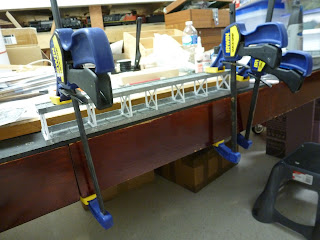Overland imported PRR F3a with antenna and an F3 b. I replaced the drive system in a set of them. I used the components from an Overland FT set with the then new end tower design. I also substituted a very large 9000 series Pittman motor which resulted in a very smooth running and powerful drive. Unfortunately, Overland did not get the details of engine correct. One noticeable point was that the pilot was a passenger pilot (which they did right) but it had bolts along the top which I am adding here.

You can see that the left side has had the many holes drilled and the bolts are on the right side. I had a heck of a time finding something to use for the bolts. I tried cast rivets - too small. Then I looked at some hex stock I had - too big. Tried some cast bolts - too big. Finally settled on small brass pins that I have had for years. The pilot also had a lever to open the knuckle on the coupler. So, I took some 1/16 brass rod and turned a handle with a knob on the end as my friend Frank Miller had shown me. I used a file to shape the handle and then soldered it to a rod through the pilot.
After the pilot, there were other issues to address. The marker box on the side had an opening that was too small and it was curved more that the prototype. So I filed that to flatten it and open it up. The PRR started with 2 inch numbers and then went to 5 inch high numbers. I hope to be able to use the 5 inch size as that was typical by the mid fifties.
Overland put steam generator related vents on the roof and the freight units were not so equipped so I had to remove them and fill in the holes ithout damaging the antenna.
They also had both antennae going down into the roof to terminate. Only one leg did that so we had to cut off the end and then fill the hole in the roof. They provided the correct horn but it had to be mounted.
As the engines were in service, they added lift lugs to aid in rerailing the units. So, I obtained castings from Bill Davis and P&D to put them on the nose of the A units.
Another view of the roof patch. I am modeling unit 9501s and 9504 which were in the first sets and assigned to Northumberland in 1950. Some of the details were unique to them.
Here is one completed engine - the future 9501.
It looks good to me!
Here is the set
Here is 9504 which is one that I bought used in about 1990 - who says O scale takes patience!
They run really quiet and well and are headed out to be painted.





































